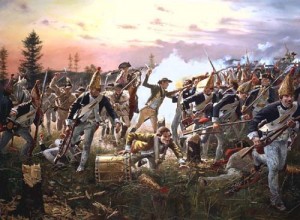The Battle of Saratoga is considered to be the major turning point of the American Revolution. This battle proved to the world that  the fledgling American army was an effective fighting force capable of defeating the highly trained British forces in a major confrontation. As a result of this successful battle, the European powers took interest in the cause of the Americans and began to support them.
the fledgling American army was an effective fighting force capable of defeating the highly trained British forces in a major confrontation. As a result of this successful battle, the European powers took interest in the cause of the Americans and began to support them.
In the British Campaign of 1777, Major General Burgoyne planned a concentric advance of three columns to meet in Albany, New York. He led the main column, which moved southward along the Hudson River. A second column under General Barry St. Leger would serve as a diversionary attack, moving eastward from Canada along the Mohawk River. General Howe would be expected to direct the third element of the attack. According to the plan, Howe would direct General Henry Clinton to move northward along the Hudson River and link up with Burgoyne in Albany. The goal of this plan was to isolate and destroy the Continental forces of New England.
Initially, the British plan appeared to be working. Burgoyne’s army continually pushed back the Americans southward along the Hudson River with only minor casualties. In an attempt to slow the British advances, the American General Philip Schuyler detached 1000 men under the command of Major General Benedict Arnold. This force moved west to thwart St. Leger’s eastward advance along the Mohawk River. Arnold returned with his detachment after repelling St. Leger in time to serve in the Battle of Saratoga.
First Battle of Saratoga: The Battle of Freeman’s Farm
The Battle of Freeman’s Farm, the First Battle of Saratoga, was an indecisive battle fought 19 September 1777 in which Gates lost ground to the British Disagreements in tactics and personalities led to a heated argument between generals Gates and Arnold, and Gates relieved Arnold of command as a result. The Battle of Bemis Heights was the second battle of Saratoga, taking place October 7th when Burgoyne desperately attacked rebel defenses with his tired, demoralized army. At Bemis Heights, Gate’s defensive tactics had insured a tactical victory for the Patriots. However, Arnold saw an opportunity to seize the offensive while Burgoyne was vulnerable and led a counterattack. This bold move so badly wounded the British forces that Burgoyne surrendered days later at Saratoga.
Second Battle of Saratoga: The Battle of Bemis Heights
After waiting several weeks for developments from General Henry Clinton’s campaign along the Hudson River, British commander  Lieutenant General John Burgoyne finally took the offensive on 7 October 1777. Like the First Battle of Saratoga, his plan focused upon a reconnaissance in force of three columns.
Lieutenant General John Burgoyne finally took the offensive on 7 October 1777. Like the First Battle of Saratoga, his plan focused upon a reconnaissance in force of three columns.
The three British columns moved out from their Freeman’s Farm fortifications in order to gain more information about the rebel positions at Bemis Heights. American General Horatio Gates, assumed to be acting upon the suggestion of Colonel Daniel Morgan, decided to assault the British forces in a three winged attack. With Morgan’s Rifle Corps attacking from the west and Poor’s Brigade from the east, Learned’s Continental Brigade moved towards the center of the British line.
The attack began at roughly 3 PM, and the Americans repeatedly broke through the British line and pushed the enemy back, only to be repelled once the British leaders rallied their scattered forces to stage a counter-offensive. British Brigadier General Simon Fraser was mortally wounded while attempting to cover the British withdrawal.
Benedict Arnold, who had been removed from command by Gates, saw an opportunity to press the advantage of the weakened British line and rode forward on his horse to take charge of Learned’s Continental Brigade. He led them towards the center of the British forces in an effort to separate the units and flank them, forcing a general withdrawal of the British forces into their fortified positions at Freeman’s Farm.
At that point, Arnold led Learned’s men to attack the British fortified in Balcarres Redoubt. After several failed attempts to overcome the defenses there, Arnold urged his horse northwest across the battlefield to join an assault on Breymann Redoubt. With superior numbers on their side, the Americans were able to breach the breastworks of the redoubt and force the British forces
